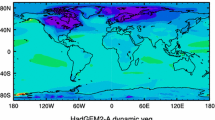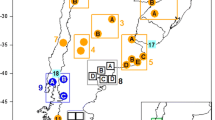Abstract
The multi-component “green” McGill Paleoclimate Model (MPM), which includes interactive vegetation, is used to simulate the next glacial inception under orbital and prescribed atmospheric CO2 forcing. This intermediate complexity model is first run for short-term periods with an increasing atmospheric CO2 concentration; the model's response is in general agreement with the results of GCMs for CO2 doubling. The green MPM is then used to derive projections of the climate for the next 100 kyr. Under a constant CO2 level, the model produces three types of evolution for the ice volume: an imminent glacial inception (low CO2 levels), a glacial inception in 50 kyr (CO2 levels of 280 or 290 ppm), or no glacial inception during the next 100 kyr (CO2 levels of 300 ppm and higher). This high sensitivity to the CO2 level is due to the exceptionally weak future variations of the summer insolation at high northern latitudes. The changes in vegetation re-inforce the buildup of ice sheets after glacial inception. Finally, if an initial global warming episode of finite duration is included, after which the atmospheric CO2 level is assumed to stabilize at 280, 290 or 300 ppm, the impact of this warming is seen only in the first 5 kyr of the run; after this time the response is insensitive to the early warming perturbation.
Similar content being viewed by others
References
Archer D, Ganopolski A (2005) A movable trigger: Fossil fuel CO2 and the onset of the next glaciation. Geochemistry Geophysics Geosystems 6: Q05003, doi:10.1029/2004GC000891
Archer D, Martin P, Buffett B, Brovkin V, Rahmstorf S, Ganopolski A (2004) The importance of ocean temperature to global biochemistry. Earth Planet Sci Lett 222:333–348
Beerling DJ, Woodward FI (2001) Vegetation and the Terrestrial Carbon Cycle. Cambridge University Press, UK
Berger A (1978) Long-term variations of daily insolation and quaternary climatic changes. J Atmos Sci 35: 2362-2367
Berger A, Gallée H, Melice JL (1991) The Earth's future climate at the astronomical time scale. In Goodess, CM, Palutikov JP (eds), Future Climate Change and Radioactive Waste Disposal NIREX Safety Series NSS/R257, Climatic Research Unit, University of East Anglia, Norwich, UK, pp. 148–165
Berger A, Loutre MF (1996) Modelling the climate response to the astronomical and CO2 forcings. Comptes Rendus De L'academie Des Sciences De Paris t.323, serie IIa, 1–16
Berger A, Loutre MF, Gallée H (1996) Sensitivity of the LLN 2-D climate model to the astronomical and CO2 forcing (from 200 kyr BP to 130 kyr AP). Scientific Report, Institut d'Astronomie et de Géophysique G. Lemaitre, Université catholique de Louvain 1996/1, 1–49
Berger A, Loutre MF, Tricot C (1993) Insolation and earth's orbital periods. J Geophys Res 98(D6), 10341–10362
Broecker WS (1998) The end of the present interglacial: how and when? Quaternary Science Reviews 17: 689–694
Brovkin V, Bendtsen J, Claussen M, Ganopolski A, Kubatzki C, Petoukhov V, Andreev A (2002) Carbon cycle, vegetation, and climate dynamics in the Holocene: Experiments with the CLIMBER-2 model. Global Biogeochemical Cycles 16(4): 1139, doi: 10.1029 / 2001GB001662
Clark PU, Pollard D (1998) Origin of the middle Pleistocene transition by ice sheet erosion of regolith. Paleoceanography 13(1): 1–9
Clark PU, Pisias NG, Stocker TF, Weaver AJ (2002) The role of the thermohaline circulation in abrupt climate change. Nature 415:863–869
Claussen et al. (2002) Earth system models of intermediate complexity: closing the gap in the spectrum of climate system models. Climate Dynamics 18(7):579–586
Cochelin A-S (2004) Simulation of glacial inceptions with the “green” McGill Paleoclimate Model. M.Sc. Thesis, McGill University. Available as C2GCR Report No. 2004-2, McGill University, Montreal, Quebec, Canada, H3A 2K6
Cox PM, Betts RA, Bunton CB, Essery RLH, Rowntree PR, Smith J (1999) The impact of the new land surface physics on the GCM simulation of climate and climate sensitivity. Climate Dynamics 15:183–203
Dickinson RE, Henderson-Sellers A, Kennedy PJ (1993) Biosphere atmosphere transfer scheme (BATS) for the NCAR community climate model. Ncar tn387+str, NCAR Technical Note, National Center for Atmospheric Research, Boulder, Colorado, Climate and Global Dynamic Division
EPICA community members (2004) Eight glacial cycles from an Antarctic ice core. Nature 429:623–628
Heinrich H (1988) Origin and consequences of cyclic ice rafting in the northeast Atlantic Ocean during the past 130,000 years. Quat Res 29:142–152
Houghton JT, Ding Y, Griggs DJ, Noguer M, van der Linden PJ, Dai X, Maskell K, Johnson CA (eds) (2001) Climate Change 2001: The Scientific Basis. Contribution of Working Group I to the Third Assessment Report of the Intergovernmental Panel on Climate Change Cambridge University Press. Cambridge, United Kingdom and New York, USA, 881pp
Indermühle A, Stocker TF, Joos F, Fischer H, Smith HJ, Wahlen M, Deck B, Mastroianni D, Tschumi J, Blunier T, Meyer R, Stauffer B (1999) Holocene carbon-cycle dynamics based on CO2 trapped in ice at Taylor Dome, Antarctica. Nature 398: 121–126
Kukla GJ, Matthews RK, Mitchell MJ (1972) Present interglacial: how and when will it end? Quat Res 2:261–269
Le Treut H, McAvaney B (2000) A model intercomparison of equilibrium climate change in response to CO2 doubling. Notes du Pole de Modelisation de l'IPSL, Institut Pierre Simon LaPlace, Paris, France No. 18
Letreguilly A, Huybrechts P, Reeh N (1991) Steady-state characteristics of the Greenland ice sheet under different climates. J Glaciol 37(125):149–157
Loutre MF (2003) Clues from MIS 11 to predict the future climate–a modelling point of view. Earth Planet Sci Lett 212:213–224
Loutre MF, Berger A (2000) Future climatic changes: Are we entering an exceptionally long interglacial? Climatic Change 46:61–90
Manabe S, Spelman MJ, Bryan K (1991) Transient responses of a coupled ocean-atmosphere model to a gradual change of atmospheric CO2. Part I: Annual mean response. J Climate 4:785–818
Manabe S, Stouffer RJ (1994) Multiple-century response of a coupled ocean-atmosphere model to an increase of atmospheric carbon dioxide. J Climate 7:5–23
Marshall SJ, Clarke GKC (1997) A continuum mixture model of ice stream thermomechanics in the Laurentide Ice Sheet, 1. Theory. J Geophys Res 102:20599–20613
Milankovitch. MM (1941) Canon of Insolation and the ice-age problem Koniglich Serbische Akad. Belgrade, Yugoslavia
Oerlemans J, Van der Veen CJ (1984) Ice sheets and climate Reidel Publishing. Dordrecht, 217pp
Petit JR, Jouzel J, Raynaud D, Barkov NI, Barnola JM, Basile I, Benders M, Chapellaz J, Davis M, Delaygue G, Delmotte M, Kotlyakov VM, Legrand M, Lipenkov VY, Lorius C, Pepin L, Ritz C, Saltzman E, Stievenard M (1999) Climate and atmospheric history of the past 420,000 years from the Vostok ice core, Antarctica. Nature 399:429–436
Petoukhov V, Claussen M, Berger A, Crucifix M, Eby M, Eliseev AV, Fichefet T, Ganopolski A, Goosse H, Kamenkovich I, Mokhov I, Montoya M, Mysak LA, Sokolov A, Stone P, Wang Z, Weaver A (2005) EMIC intercomparison project (EMIP - CO2): Comparative analysis of EMIC simulations of current climate and equilibrium and transient reponses to atmospheric CO2 doubling. Climate Dynamics 25:363–385, doi: 10.1007/s00382-005-0042-3
Rahmstorf S, Ganopolski A (1999) Long-term global warming scenarios computed with an efficient coupled climate model. Climatic Change 43:353–367
Ruddiman WF (2001) Earth's Climate: Past and Future. W.H. Freeman and Company, New York
Ruddiman WF (2003) Orbital insolation, ice volume and greenhouse gases. Quaternary Science Review 22:1597–1629
Saltzmann B, Maasch KA, Verbitsky MY (1993) Possible effects of anthropogenically-increased CO2 on the dynamics of climate: implications for ice age cycles. Geophys Res Lett 20:1051–1054
Shackleton NJ, Opdyke ND (1976) Oxygen isotope and paleomagnetic stratigraphy of Pacific core V28-239, late pliocene to latest pleistocene. Mem Geol Soc Am 145:449–464
Vettoretti G, Peltier WR (2004) Sensitivity of glacial inception to orbital and greenhouse gas climate forcing. Quaternary Science Review 23(3-4):499–519
Wang Y, Mysak LA, Wang Z, Brovkin V (2005a) The greening of the McGill Paleoclimate Model. Part I: Improved land surface scheme with vegetation dynamics. Climate Dynamics 24:469–480, doi: 10.1007/s00382-004-0515-9
Wang Y, Mysak LA, Wang Z, Brovkin V (2005b) The greening of the McGill paleoclimate model. Part II: simulation of holocene millennial-scale natural climate changes. Climate Dynamics 24:481–496, doi: 10.1007/s00382-004-0516-8
Wang Y, Mysak LA, Roulet NT (2005c) Holocene climate and carbon cycle dynamics: Experiments with the “green” McGill paleoclimate model. Global Biogeochemical Cycles 19, GB3022, doi:10.1029/2005GB002484
Wang Z (2005) Two climatic states and feedbacks on thermohaline circulation in an Earth system model of intermediate complexity. Climate Dynamics 25:299–314, doi: 10.1007/s00382-05-0033-4
Wang Z, Mysak LA (2000) A simple coupled atmosphere-ocean-sea ice-land surface model for climate and paleoclimate studies. J Climate 13:1150–1172
Wang Z, Mysak LA (2002) Simulation of the last glacial inception and rapid ice sheet growth in the McGill Paleoclimate Model. Geophys Res Lett 29(23):2102, doi: 10.1029/2002GL015120
Wang Z, Hu R-M, Mysak LA, Blanchet J-P, Feng J (2004) A parameterization of solar energy disposition in the climate system. Atmosphere-Ocean 42(2):113–125
Wang Z, Cochelin A-SB, Mysak LA, Wang Y (2005) Simulation of the last glacial inception with the green McGill paleoclimate model. Geophys Res Lett 32:L12705 doi: 10.1029/2005GL023047
Wood RA, Vellinga M, Thorpe RB (2003) Global warming and thermohaline circulation stability. Phil. Trans R Soc London A361, 1961–1975
Author information
Authors and Affiliations
Corresponding author
Rights and permissions
About this article
Cite this article
Cochelin, AS.B., Mysak, L.A. & Wang, Z. Simulation of long-term future climate changes with the green McGill paleoclimate model: the next glacial inception. Climatic Change 79, 381–401 (2006). https://doi.org/10.1007/s10584-006-9099-1
Received:
Revised:
Accepted:
Published:
Issue Date:
DOI: https://doi.org/10.1007/s10584-006-9099-1




